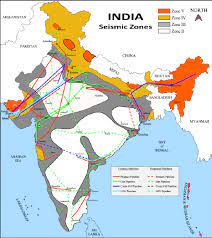Pipeline networks have a significant impact on the transportation of various materials in India. This article provides an overview of the Pipeline Network in India, highlighting the critical players, the materials transported, and the advantages of the pipeline network.

Table of Contents
Overview of Pipeline Network in India
India’s pipeline network covers over 18,000 kilometers across the country and is managed and operated by public and private sector companies. The network is divided into various categories such as crude oil pipelines, petroleum product pipelines, and natural gas pipelines.
Crude Oil Pipelines
Crude oil pipelines transport crude oil from oil fields to refineries across the country. Public and private sector companies such as Indian Oil Corporation (IOC), Bharat Petroleum Corporation Limited (BPCL), and Hindustan Petroleum Corporation Limited (HPCL) operate the crude oil pipelines in India.
Petroleum Product Pipelines
Petroleum product pipelines transport various petroleum products such as diesel, petrol, and aviation turbine fuel from refineries to different distribution points across the country. Public and private sector companies such as IOC, BPCL, and HPCL operate the petroleum product pipelines in India.
Natural Gas Pipelines
Natural gas pipelines transport natural gas from gas fields to various cities and industries for domestic and industrial use. Public and private sector companies such as Oil and Natural Gas Corporation (ONGC) and GAIL India operate the natural gas pipelines in India.
Key Players in Pipeline Networks in India
Public and private sector companies operate and manage the pipeline network in India. The prominent players include GAIL India, IOC, BPCL, HPCL, and Reliance Gas Transportation Infrastructure Limited (RGTIL).
GAIL India’s Pipeline Network
GAIL India operates the largest pipeline network in India, covering over 13,000 kilometers of natural gas pipelines across the country. The company’s pipeline network connects various cities such as Delhi, Mumbai, Kolkata, and Chennai and industries such as power plants, fertilizers, and steel plants. GAIL also operates a network of Liquefied Petroleum Gas (LPG) pipelines.
IOC’s Pipeline Network
IOC also operates a vast network of pipelines that transport crude oil, petroleum products, and natural gas across the country. The company’s pipeline network covers over 13,000 kilometers and connects various refineries and distribution points across the country.
RGTIL’s Pipeline Network
RGTIL operates a pipeline network that transports natural gas from the KG D6 gas fields in the Bay of Bengal to various cities in India.
Advantages of Pipeline Network
The pipeline network in India offers several advantages such as cost-effectiveness, safety, and reliability. Pipelines are considered one of the safest and most reliable modes of transportation for various materials, including oil, gas, and other liquids. Pipelines also offer significant cost advantages over other modes of transportation such as rail and road transport.
List of Important Pipeline Networks in India
India has an extensive network of pipeline infrastructure that plays a crucial role in the transportation of various commodities across the country. Here is a list of important pipeline networks in India:
- Indian Oil Corporation Limited (IOCL) Pipeline Network:
- Mathura-Jalandhar Pipeline (MJPL)
- Paradip-Haldia-Durgapur Pipeline (PHDPL)
- Salaya-Mathura Crude Oil Pipeline (SMPL)
- Koyali-Sanganer Product Pipeline (KSPL)
- Kandla-Gorakhpur LPG Pipeline (KGPL)
- Gas Authority of India Limited (GAIL) Pipeline Network:
- Hazira-Vijaipur-Jagdishpur (HVJ) Pipeline
- Dahej-Vijaipur Pipeline (DVPL)
- Vijaipur-Dadri-Bawana-Nangal Pipeline (VDBPN)
- Dabhol-Bengaluru Pipeline (DBPL)
- Kochi-Koottanad-Bengaluru-Mangaluru Pipeline (KKBMPL)
- Reliance Gas Transportation Infrastructure Limited (RGTIL) Pipeline Network:
- East-West Gas Pipeline (EWPL)
- West Coast Gas Pipeline (WCGPL)
- Kakinada-Srikakulam Gas Pipeline (KSGPL)
- Gujarat State Petronet Limited (GSPL) Pipeline Network:
- Mehsana-Bhatinda Pipeline
- Anjar-Viramgam Pipeline
- Mundra-Delhi Pipeline
- Hazira-Vijaipur-Jagdishpur (HVJ) Pipeline (part of GAIL network)
- Oil and Natural Gas Corporation (ONGC) Pipeline Network:
- Mumbai High-Uran Trunk Pipeline
- Hazira-Bijaipur-Jagdishpur (HBPL) Pipeline
- Chennai Petroleum Corporation Limited (CPCL) Pipeline Network:
- Manali-Chennai Pipeline (MCP)
- Chennai-Trichy-Madurai Pipeline (CTMP)
- Essar Pipeline Network:
- Vadinar-Rajkot-Ankleshwar Pipeline
- Salaya-Mathura Pipeline
- Haldia-Budge-Budge Pipeline:
- A pipeline network connecting Haldia in West Bengal to Budge-Budge in Kolkata for petroleum products transportation.
- Mangaluru-Hassan-Mysuru-Bengaluru Pipeline:
- A pipeline network for transportation of petroleum products from Mangaluru to Bengaluru, passing through Hassan and Mysuru.
- Numaligarh-Siliguri Pipeline:
- A pipeline network connecting the Numaligarh Refinery in Assam to Siliguri in West Bengal for transportation of petroleum products.
These are some of the prominent pipeline networks in India that facilitate the transportation of crude oil, petroleum products, natural gas, and other commodities across different regions of the country.
Conclusion
In conclusion, the pipeline network in India plays a crucial role in the transportation of various materials across the country. The extensive pipeline network, managed and operated by various public and private sector companies, has helped India to meet its growing energy needs and ensure the efficient transportation of petroleum products, natural gas, and other materials across the country.
Important Links